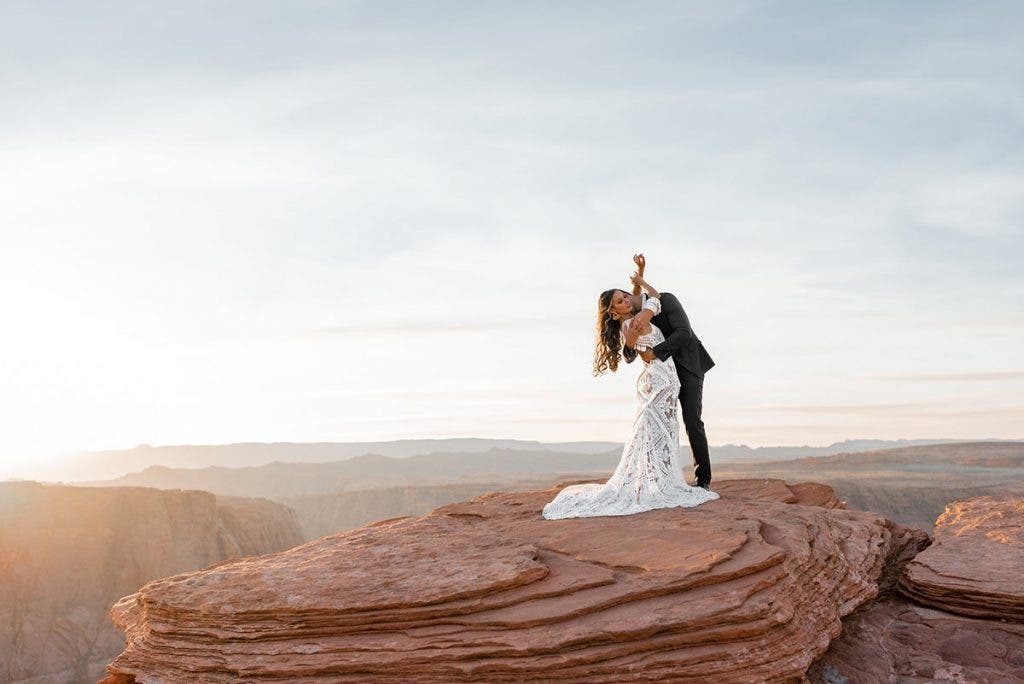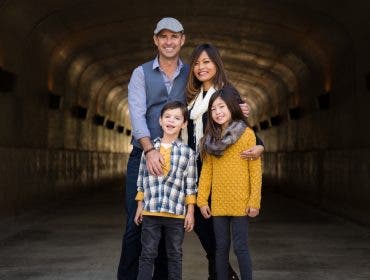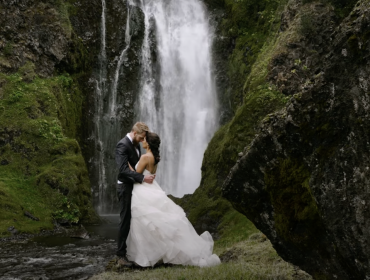Being a wedding photographer requires tremendous skill, talent, and patience. But to be able to produce beautiful images that perfectly captures every emotion, every happy moment, and every glorious detail of the bride and groom’s most special day, there is one thing that every wedding photographer needs: the best camera for the job. Wedding photography is a demanding job that requires a high-performance DSLR camera designed and built to not only meet but exceed the photographer’s needs in terms of speed (to capture those important fleeting moments that can never be repeated) and image quality.
With that said, a full-frame DSLR camera such as the Canon EOS 5D Mark IV or the Nikon D850 is the best and most logical options for wedding photography. Due to their large sensors, full-frame cameras produce the sharpest, most detailed images, which is absolutely crucial in wedding photography, where perfection is of the utmost importance.

Best Pro-Level DSLR Camera for Wedding Photography
If you’re looking for a DSLR body that can capture stunning wedding photos, we’ve listed down the best wedding cameras to help you out.
Canon EOS 5D Mark IV
Canon’s new-generation EOS 5D DSLR gives you much better image quality, performance, and versatility. This powerful camera body features a 30.4-megapixel full-frame sensor for fine image quality, as well as highly detailed 4K video. Plus, an improved 61-point AF system and a Dual Pixel AF function offer fast and smooth AF when you capture video and use the camera’s Live View mode. Both features help achieve more precise focus.
Apart from its sensor and AF capabilities, the EOS 5D Mark IV comes with a DIGIC 6+ processor for faster operation anytime, anywhere. It even has built-in Wi-Fi, GPS, and an intuitive touch-panel LCD to make photo sharing and adjusting camera settings a breeze.
Check out our first look review of the Canon EOS 5D Mark IV with wedding photographer Vanessa Joy.
Key Features:
- 30.4-Megapixel CMOS Sensor
- Canon EF Lens Mount
- ISO 100-32000 Sensitivity (Expandable to ISO 50-102400)
- Up to 7 fps of Continuous Shooting
- DCI 4K Video up to 30p & Full HD Video up to 60p (in MOV and MP4 Formats)
- 61-Point Autofocus System (Phase-Detection)
- 1.62m-Dot Fixed Touchscreen LCD
Canon EOS 90D
Canon built the EOS 90D model for creatives bent on improving their photography skills (including wedding photographers). It’s got a 100% coverage optical viewfinder with a 45-point, cross-type AF system, as well as continuous shooting at up to 10 fps for capturing decisive moments. Plus, the camera’s Live View mode features 5,481 selectable focus positions and Eye Detection AF. Both features leave you free to compose your shots in any way you want.
The EOS 90D also delivers better operability in various shooting conditions, thanks to its moisture and dust-resistant design, new multi-controller, and improved shutter button.
Key Features:
- 32.5-Megapixel CMOS Sensor
- Canon EF-S Lens Mount
- ISO 100-25600 Sensitivity (Expandable to ISO 100-51200)
- Up to 10 fps of Continuous Shooting
- UHD 4K Video at up to 30p
- 45-Point Autofocus System (Phase-Detection and Cross-Type)
- 1.04m-Dot Articulating Touchscreen LCD
Nikon D850
Our first Nikon wedding photography camera comes with a 45.7-megapixel resolution for quick action shots. The D850’s sensor delivers this superb resolution, as well as more efficient light collection, faster data readout, and nearly moiré-free, truer shades.
Nikon also built its EXPEED 5 processor into this well-rounded camera body: it makes images less noisy with faster megapixel processing. EXPEED 5’s processing speed delivers a broader dynamic range, subtle tones and texture, and quick continuous shooting at around 9 fps, too. You can achieve the latter with the optional MB-D18 battery pack.
And for exceptional AF while you’re shooting weddings, D850 cameras have some helpful AF-related features. They include a 153-point AF system, 99 cross-type points, and a dedicated AF processor.
Key Features:
- 45.7-Megapixel CMOS Sensor
- Nikon F Lens Mount
- ISO 64-25600 Sensitivity (Expandable to ISO 32-102400)
- Up to 9 fps of Continuous Shooting Using Nikon’s MB-D18 Battery Grip
- UHD 4K Video at up to 30p
- 153-Point Autofocus System (Phase-Detection) with 99 Cross-Type Points
- 2.359m-Dot Tilting Touchscreen LCD
Nikon D7500
With the same game-changing resolution, ISO range, processing capability, and energy efficiency as the D500, the D7500 offers superb performance for bridal photography. It has a 20.9-megapixel CMOS sensor with no low-pass filter to keep image resolution and low-noise performance optimally balanced. Meanwhile, an EXPEED 5 processor easily manages fast continuous shooting and UHD 4K video recording at 30p.
And speaking of continuous shooting, D7500 units will let you take photos of elusive subjects at up to 8 fps. They also feature versatile 51-point AF and Group Area AF for quick focus on erratic and low-contrast subjects. Capturing crisper low-light photos with less noise is possible as well, thanks to this camera’s broad ISO sensitivity range.
Key Features:
- 20.9-Megapixel CMOS Sensor
- Nikon F Lens Mount
- ISO 100-51200 Sensitivity (Expandable to ISO 50-1640000)
- Up to 8 fps of Continuous Shooting
- UHD 4K Video at up to 30p
- 51-Point Autofocus System (Phase-Detection) with 15 Cross-Type Points
- 922k-Dot Tilting Touchscreen LCD
Canon EOS 1DX Mark III
This full-frame camera has the best overall image quality for Canon with clean, noise-free images. The Canon EOS 1DX Mark III is a beast in low light, and is built to handle anything, whether indoors or outdoors. Apart from wedding photography, it’s great for sports and wildlife, as well as candids using existing light. Don’t be put off by its 20.1MP lower resolution sensor—you can still get amazing blow-ups, plus faster processing time (20fps continuous shooting) with this camera.
Other pluses include improved AF performance and a maximum ISO 102,400 that can be pushed to 819,200. Sensor performance is also a significant improvement over its predecessors.
Key Features:
- 20.1-Megapixel CMOS Sensor
- Canon EF Lens Mount
- ISO 100-102,400 Sensitivity (Expandable to ISO 50-819,200)
- Up to 20 fps of Continuous Shooting
- 4K Video at up to 60p
- 525-Point Autofocus System (Phase-Detection)
Canon EOS 6D Mark II
The Canon EOS 6D Mark II offers the best of all worlds for wedding photographers. It’s a DSLR, but it’s also compact and lightweight. It boasts a 26.2 megapixel sensor for stunning, high-resolution images, plus a stellar optical viewfinder with 45 AF points to ensure quick and precise autofocusing. The camera’s vari-angle touch screen LCD gives photographers ultimate ease when it comes to monitoring their work, while Full HD at 60p lets photographers dabble into video, be it for clients or social-media promotion.
The Canon EOS 6D Mark II also comes with Wi-Fi connectivity, meaning photographers can get images straight on their phones to either share with clients or post to social in celebration once the wedding day’s complete.
Key Features:
- 26.2 Megapixel Full-frame CMOS Sensor
- Canon EF Lens Mount
- ISO 100 to 40000 Sensitivity (Extended to 50 to 102400)
- Up to 6.5 fps of Continuous Shooting
- UHD Full HD at up to 24p
- Autofocus System (Phase-Detection) with 45 Cross-Type Points
- 1.04m-Dot Articulating Touchscreen LCD

Things to Consider When Choosing a DSLR Camera
Eyeing a new DSLR to shoot weddings? Here are some factors you should look into before buying one.
Price
The price range for DSLRs varies, but you can get a budget-friendly DSLR body like the Nikon D7500 that’s got the same image quality as its more high-end peers.
Dynamic Range
When photographing a bride and groom, you need to capture everything from the fine detail of her white dress to the subtle shadows of his black tux. The camera with the widest dynamic range, and the highlight and shadow sliders in post-processing of RAW images, are your best friends.
Overall Image Quality
This factor is, of course, most important when marketing your keepsake large prints. You will want the lowest noise at the highest ISO option available, so this makes full-frame DSLRs pretty much a requirement.
Autofocus
Wedding albums will mostly have shots of moving subjects, and that’s why having fast, precise AF is a huge advantage for wedding cameras. Our advice? Find a camera with more AF points and read user reviews to see what others are saying about the performance.
Most DSLRs also include their detection range in their tech specs. Detection range simply refers to the range of light that a camera can use for focus. You can compare cameras by looking at the lowest number (e.g. -3 EV of AF will offer better low-light performance than -2 EV of AF).
Low-Light Performance
Along with sensor and AF performance, you should also check the ISO performance of the camera you’re eyeing. DxOMark and user reviews are great places to look for a model’s ISO rating. We’ve included ISO ranges for every camera we’ve featured in this article, so you can picture how they’ll fare in low-light scenes.
User Interface
User interface is less of an important feature because with experience you can get used to any layout, and at this level, you can customize your camera to fit your preferences. That said, moving up to the latest version of the camera and brand you already have reduces the learning curve, and many photographers find that to be a big benefit.
Durability
You want a well-made camera with a well-constructed body and a shutter that is rated for hundreds of thousands of clicks, because you’ll be taking a lot of pictures.
System
Canon and Nikon have the most extensive lens, flash, and accessory systems geared for professionals. Sony is catching up. And for the more skilled pros, Pentax has a full-frame DSLR under $2,000. Image quality is extraordinary and while the lenses for this camera are excellent, the system is more limited.
Accessories & Extra Features
Before buying that wedding DSLR, make sure to look at the available lenses and flashes for it. When it comes to lenses, you should check if your desired model has the lens you’ll need or want. We’ll talk more about the lenses that wedding photographers use in our FAQ section.
As for flash units, make sure you get a compatible hot-shoe flash and a wireless set. You can use off-camera flash with these accessories.
A camera’s extra features can also help a lot in shooting weddings. Dual SD card slots, battery life, and video capabilities are a few things you should consider when picking the best camera for wedding photography.

Frequently Asked Questions about Wedding DSLRs
Mirrorless vs DSLR cameras for wedding photography: which one do you choose?
While wedding photographers have and continue to use mirrorless and DSLR cameras successfully, many new photographers want to know which type is the best camera for wedding photography both now and into the future. According to experts, the answer depends.
Mirrorless cameras have a number of important wedding-photography features. For starters, mirrorless cameras are almost always smaller and more portable that DSLRs. That means lugging gear from prep to ceremony and beyond won’t break your back. Additionally, mirrorless cameras are known to have better autofocusing options, largely due to the single AF system (while DSLRs have phase detection). Plus, mirrorless cameras can shoot at faster shutter speeds via an electronic shutter.
But, DSLR cameras have been a staple for years because of their reliability, and some of their perks make them just as good, if not better, for wedding photography. This includes a solid, steady body that works well with large lenses, plus high image quality, long battery life, and more.
At the end of the day, it’s the photographer, not the camera, that matters most. Choose a camera that has the features you desire, and you’ll be well on your way!
What lenses should I use to shoot wedding photos?
Most wedding photographers use a variety of lenses with different focal lengths. These lenses typically include a 24-70mm f/2.8 wide-angle lens and a 70-200mm f/2.8 telephoto lens. For macro lenses, the 100mm lens is a popular choice among wedding photography pros. Bright primes at various focal lengths (85mm, 50mm) are optional.
Can I shoot weddings with a crop sensor camera?
If you know how the crop sensor will change your shooting experience, then you can use a crop sensor camera to capture weddings. Using your lenses on APS-C cameras means that their equivalent focal length will change. A smaller sensor offers a longer focal length. Crop sensors will also make you appear closer to subjects.
How many megapixels should I use for wedding photography?
It all depends on your camera’s standard megapixel count. Higher megapixel counts mean higher detail in your shots. Modern DSLRs (and other types of cameras) make anything above 20MP perfect for capturing various types of images, including wedding photography. But more megapixels can also be a disadvantage since they give your precious images bigger file sizes.
Are wedding cameras good for other kinds of photography?
Yes, but it depends on the other types of subjects you’re shooting or the niches you’re also interested in. If you’re into photographing indoor events (apart from weddings), low-light DSLR models are much better at handling these situations, especially if they don’t use extra lighting.
How many cameras should a wedding photographer have?
When new photographers break into the wedding world, they almost always ask the question: Can you shoot a wedding with one camera? The short answer: Sure you can—but you’re better off with at least two. That’s because wedding days move quickly, and when important moments happen, you can’t fumble around with changing your lenses.
Most wedding photographers opt to have one style of lens on one camera and one on another (e.g., a 50mm prime and a telephoto for close-ups). So, while you could shoot a wedding with one camera, you’ll have more versatility—and likely better-quality images—if you use two with prime or higher-quality lenses.
Do I need a backup wedding camera?
If your primary camera breaks or malfunctions, another model in your wedding photography equipment bag is a must. You can even rent your additional camera if you’re on a budget. Our list has backup DSLRs from Canon and Nikon, because if there’s one thing every professional photographer should have, it’s a good, reliable back-up camera.






